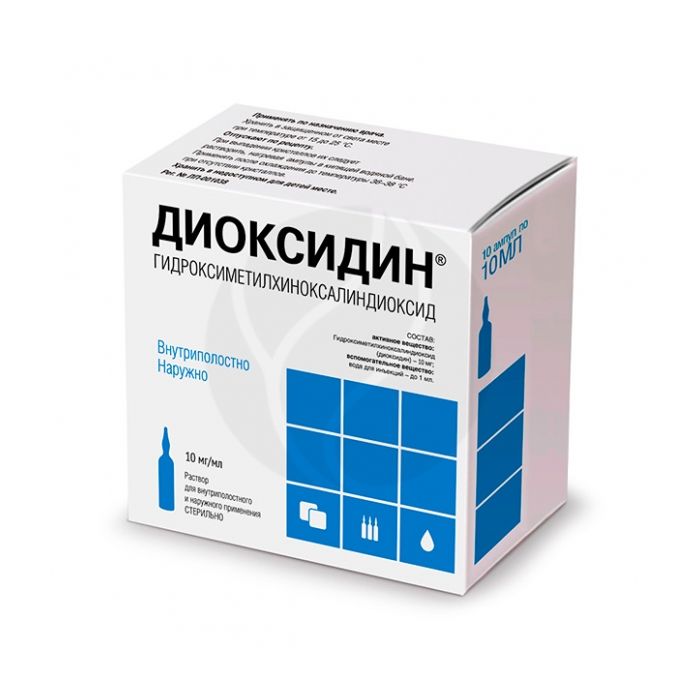Dioxidine solution for intracavity and external applications. 1%, 10ml # 10
Expiration Date: 05/2027
Russian Pharmacy name:
Диоксидин раствор д/внутриполост.мест.и наруж.прим. 1%, 10мл №10
purulent bacterial infections caused by sensitive microflora with the ineffectiveness of other chemotherapeutic agents or their poor tolerance.
External use
superficial and deep wounds of various localization;
long-term non-healing wounds and trophic ulcers;
phlegmon of soft tissues; infected burns;
purulent wounds with osteomyelitis.
Intracavitary introduction
purulent processes in the chest and abdominal cavity;
with purulent pleurisy, pleural empyema, lung abscesses, peritonitis, cystitis, wounds with deep purulent cavities (soft tissue abscesses, phlegmon of pelvic tissue, postoperative wounds of the urinary and biliary tract, purulent mastitis).
Dioxidine is prescribed in a hospital setting.
Applied externally, intracavitary. 1% Dioxidine solution cannot be used for intravenous administration, due to the instability of the solution during storage at low temperatures.
External use
Apply 0.1-1% solutions of Dioxidine. To obtain 0.1-0.2% solutions, ampoule solutions of the drug are diluted to the desired concentration with sterile isotonic sodium chloride solution or water for injection.
For the treatment of superficial infected purulent wounds, napkins moistened with 0.5-1% dioxidine solution are applied to the wound. Deep wounds after treatment are loosely tamponed with tampons moistened with 1% dioxidine solution, and in the presence of a drainage tube, 20 to 100 ml of a 0.5% solution of the drug are injected into the cavity.
For the treatment of deep purulent wounds in osteomyelitis (wounds of the hand, foot), 0.5-1% solutions of the drug are used in the form of baths or a special treatment of the wound with a solution of the drug is carried out for 15-20 minutes (the solution is injected into the wound for this period), followed by dressing with 1% dioxidine solution. Dioxidine in the form of 0.1-0.5% solutions can be used to prevent infection after surgery. According to indications (patients with osteomyelitis) and with good tolerance, treatment can be carried out daily for 1.5-2 months.
Intracavitary injection Into the purulent cavity, depending on its size, 10-50 ml of 1% dioxidine solution / day is injected. The dioxidine solution is injected into the cavity through a catheter, drainage tube, or syringe. The maximum daily dose for the introduction into the cavity is 70 ml of a 1% solution. The drug is usually injected into the cavity 1 time / day. According to indications, it is possible to introduce a daily dose in two steps. With good tolerance and indications, the drug can be administered daily for 3 weeks or more. If necessary, repeated courses are carried out after 1-1.5 months.
Solution for intracavitary and external use
1% light yellow with a greenish tint, transparent. 1 ml 1 amp.
hydroxymethylquinoxaline dioxide 10 mg 100 mg
Excipients: water d / i.
adrenal insufficiency (including history);
pregnancy;
lactation period;
childhood;
hypersensitivity to dioxidine.
With caution - renal failure.
pharmachologic effect
A broad-spectrum antibacterial drug from the group of quinoxaline derivatives, has chemotherapeutic activity for infections caused by Proteus vulgaris, dysentery bacillus, Klebsiella, Pseudomonas aeruginosa, Salmonella, staphylococci, streptococci, pathogenic anaerobes (including gangrenous pathogens) bacteria resistant to other chemotherapy drugs, including antibiotics. The development of drug resistance of bacteria is possible. When administered intravenously, it is characterized by a small therapeutic breadth, and therefore it is necessary to strictly adhere to the recommended doses. Treatment of burns and purulent-necrotic wounds promotes faster cleaning of the wound surface, stimulates reparative regeneration and marginal epithelization, and has a beneficial effect on the course of the wound process.
Pharmacokinetics
When applied topically, it is partially absorbed from the wound or burn surface, excreted by the kidneys.
Side effect
With intracavitary administration, headache, chills, fever, dyspeptic disorders, convulsive muscle contractions, allergic reactions, photosensitizing effect (the appearance of pigmented spots on the body when exposed to sunlight) are possible. When applied externally - near-wound dermatitis.
Application during pregnancy and lactation
Contraindicated during pregnancy and lactation.
Application for impaired renal function
With caution - renal failure. In chronic renal failure, the dose is reduced.
special instructions
Dioxidine is prescribed only for adults. Before starting the course of treatment, a test is carried out for the tolerance of the drug, for which 10 ml of a 1% solution is injected into the cavity. In the absence of side effects (dizziness, chills, fever) within 3-6 hours, a course treatment is started. Dioxidine is prescribed only for severe forms of infectious diseases or with the ineffectiveness of other antibacterial drugs, incl. cephalosporins of II-IV generations, fluoroquinolones, carbapenems. In chronic renal failure, the dose is reduced. When pigment spots appear, the duration of a single dose is increased to 1.5-2 hours, the dose is reduced, antihistamines are prescribed or Dioxidin is canceled. In case of precipitation of Dioxidine crystals in ampoules with a solution during storage (at a temperature below 15 ? C), they are dissolved,heating the ampoules in a boiling water bath with shaking until the crystals are completely dissolved (clear solution). If, when cooled to 36-38 ? C, the crystals do not fall out again, the drug is usable.
'
